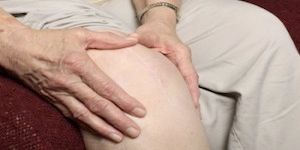Article
Guidelines for Knee Osteoarthritis Management Miss Treatment Targets
Author(s):
Though different sets of treatment recommendations for knee osteoarthritis send conflicting messages to practicing physicians, James W. Atchison, DO, pointed out that the guidelines focus solely on the knee, while pain management specialists focus on the whole person.

Though different sets of treatment recommendations for knee osteoarthritis (OA) send conflicting messages to practicing physicians, James W. Atchison, DO, Medical Director of the Center for Pain Management at the Rehabilitation Institute of Chicago, pointed out that the guidelines focus solely on the knee, while pain management specialists focus on the whole person.
“There are different subgroups of patients with knee OA — some whose treatment may need to extend beyond the knee joint — yet we treat them all the same while referring to guidelines that only looked at knee pain,” Atchison said during the “Management of Knee OA: What Is Missing from the Treatment Guidelines?” presentation at the American Academy of Pain Medicine (AAPM) 2014 Annual Meeting, held March 6-9, 2014, in Phoenix, AZ. “We should read the guidelines, but as pain physicians, we should also think of the big picture.”
In his review of the current orthopedic guidelines for knee OA, D.J. Kennedy, MD, of the Stanford University Department of Orthopaedic Surgery, indicated where the American College of Rheumatology (ACR) 2012 guidelines and American Academy of Orthopedic Surgery (AAOS) 2013 guidelines agreed or disagreed on certain treatment recommendations.
For example, the ACR and AAOS guidelines both overlapped on recommending against the use of glucosamine and strongly recommending weight loss for knee OA patients with a body mass index (BMI) >25, in addition to participation in cardiovascular and resistance land-based exercise. However, Kennedy said the AAOS found strong evidence to recommend against the use of acupuncture, acetaminophen, and lateral wedge insoles for knee OA patients, while the ACR gave those 3 treatment approaches a conditional green light. Nevertheless, the 2 guidelines partially agree that the clinical evidence available on the use of transcutaneous electrical stimulation in knee OA is lacking.
While dissecting the adage that “exercise is medicine,” Kennedy noted the AAOS guideline found strong evidence to endorse strengthening exercises for the treatment of knee OA, but out of the 37 studies it considered for the recommendation, only 3 showed clinical significance. Still, Kennedy said “even though the literature doesn’t support it, the recommendation still makes sense,” as knee OA has been shown to improve with as few as 3 weight-lifting sessions per week.
However, Atchinson said the treatment target is “not just a single joint, but the whole person,” so interdisciplinary principles of pain management may be more applicable to particular subgroups of knee OA patients than standardized therapeutic guidelines.
“When you look at the psychological profiles of knee OA patients, they can be clustered into 4 separate groups. Patients in Cluster 4 may likely need an interdisciplinary treatment targeting the central mechanisms of sensitization in addition to their peripheral pain, while those in Cluster 1 may just need an anti-inflammatory medication,” Atchison explained.
In fact, data presented by Robert Norman Harden, MD, the Addison Chair in Pain Studies at Northwestern University, corroborated that changes in peripheral sensitization and central processing are important mechanisms in knee OA, similar to the role they have in most chronic pain conditions.
“Additional research is needed to both identify new strategies and further evaluate existing therapies that target central aspects of OA-related pain, (which) has lagged behind peripherally directed treatments,” Atchison concluded. “The existing screening tools are too cumbersome for busy care providers, and simpler methods are needed for clinicians to readily identify patients who many benefit more from treatments that target central pain mechanisms.”





